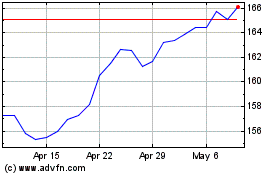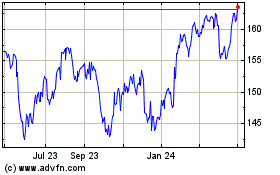By Sharon Terlep
Procter & Gamble Co. is winning over shoppers with help from
aggressive discounting that is rippling through the household-goods
industry.
The maker of Tide detergent and Pampers diapers on Tuesday said
average prices on its products fell in the most recent quarter for
the first time since 2011. The discounting helped P&G boost
sales in most of its business segments but has weighed on
rivals.
The lower prices were one of several factors cited by
Kimberly-Clark Corp., whose brands include Huggies diapers and
Cottonelle toilet paper, as it unveiled Tuesday a sweeping
restructuring amid weak sales.
The dynamics set up a tug-of-war this year between
consumer-products companies, which are pouring money into new
products and marketing in hopes of commanding higher prices, and
retailers and shoppers who are becoming increasingly accustomed to
discounts.
P&G has been under pressure from activist investor Trian
Fund Management to improve its performance, and recently ended a
high-profile proxy fight by giving Trian co-founder Nelson Peltz a
seat on its board. Mr. Peltz has argued the company is overly
complex and has failed to keep pace with recent trends.
On Tuesday, P&G's finance chief Jon Moeller said the lower
prices won't be sticking around. He said P&G's moves are a
response to industry trends, including discounts by rivals and a
proliferation of cheaper private-label products. As they battle for
shoppers, retailers such as Wal-Mart Stores Inc. and Amazon.com
Inc. have been pushing lower prices and store brands.
"That's why in many ways we've chosen to focus our portfolio
where we have, which is in categories where performance drives
consumer choice," Mr. Moeller said in a call with analysts, several
of whom pressed for information on pricing. "Our strategy is
designed to find the best path to a better place."
Mr. Moeller said the company aims to combat price pressure with
new offerings and by focusing on the higher end of the market,
where products have richer margins and shoppers are more willing to
spend. He pointed to a new Oral B power toothbrush and pricier new
Olay skincare products as examples.
P&G said organic sales, a closely watched metric that strips
out currency moves, acquisitions and divestitures, rose 2% in the
quarter ended Dec. 31.
Lower prices had the biggest impact on P&G's grooming
segment, where the company last year took the unusual step of
publicly announcing plans to slash prices across the Gillette razor
brand amid market share losses to cheaper online competitors. But
pricing also fell by 1% on average in its healthcare, household
goods and personal-care units.
Bernstein analyst Ali Dibaj questioned whether lower prices are
a new reality for the industry, a particular concern for investors,
he said, since prices on materials such as pulp and oil, have been
going up.
"Arguably you have been pricing below your market inflation
rates for years now," Mr. Dibaj said on the call with P&G. In
the consumer-products industry, "pricing not keeping up with
inflation seems to be a bit of a trend now. Is this retailers
pushing back? Are consumers saying, 'These are commodities'?"
"You are right to point to this as a pain point in the immediate
present, " said Mr. Moeller in response.
In recent quarters, the consumer giant has said it was puzzled
by sluggish consumer spending on household staples such as paper
towels and shampoo, and has been trying to spiff up its products
spur sales.
In all for its fiscal second quarter, the Cincinnati-based
company reported earnings of $2.5 billion, or 93 cents a share,
down from a profit of $7.88 billion, or $2.88 a share, a year
earlier. The prior year's quarter included a benefit from a
divestiture. On an adjusted basis, earnings rose 10% to $1.19 per
share.
Quarterly revenue rose 3.2% to $17.4 billion.
P&G's decision to streamline its beauty business by selling
the bulk of it to Coty Inc. in 2016 helped organic sales in the
segment to jump 9% -- the largest margin among company segments --
during the quarter.
P&G's shares fell 3% to $89.13 in morning trading. The stock
has risen about 3% over the past 12 months, while the S&P 500
index has surged to a 25% gain.
Earlier in the day, Kimberly-Clark said it will cut about 13% of
its global workforce, or at least 5,000 jobs, as the company
grapples with sluggish sales of household staples.
The Irving, Texas-based company, which announced the job cuts as
it reported fourth-quarter results, had entered 2017 predicting 2%
organic sales growth but ended the year with flat sales. It expects
just 1% growth for 2018.
Kimberly-Clark Chief Executive Tom Falk said in an interview
that P&G's discounting, along with other factors such as women
having fewer babies and pressure from retailers, is driving down
prices across the industry.
However, he said, the competition hasn't reached the intensity
of previous eras. "It's not the worst I've ever seen by far," he
said, recalling a time in 1990s when P&G cut diaper prices by
10%. "There have been more aggressive price wars."
Imani Moise contributed to this article.
Write to Sharon Terlep at sharon.terlep@wsj.com
(END) Dow Jones Newswires
January 23, 2018 11:51 ET (16:51 GMT)
Copyright (c) 2018 Dow Jones & Company, Inc.
Procter and Gamble (NYSE:PG)
Historical Stock Chart
From Mar 2024 to Apr 2024

Procter and Gamble (NYSE:PG)
Historical Stock Chart
From Apr 2023 to Apr 2024
